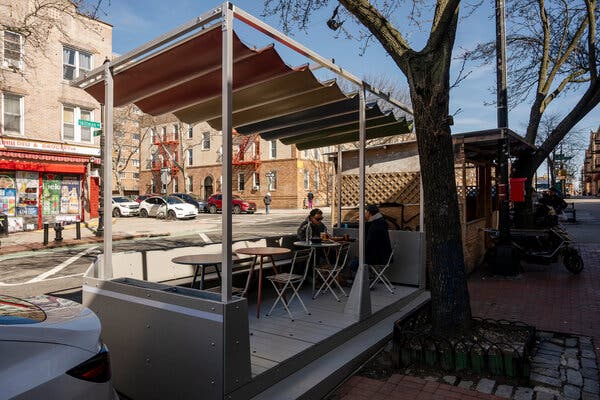Front Burner
The city’s Department of Transportation issued new rules for Dining Out NYC, its official program, and more food news.
Like them or not, the outdoor dining sheds that have been an upshot of the pandemic are more or less here to stay. Last week, City Hall and the Department of Transportation issued new guidelines for Dining Out NYC, its official program, and the largest such program in the country. “It’s been a priority for Mayor Adams from Day 1,” said Ya-Ting Liu, the city’s chief public realm officer. Restaurants and other establishments that serve food can now apply for permits to take part through an official portal online. Those that are approved and pay a fee for a four-year license ($1,050) for either a roadbed or sidewalk enclosure have 30 days to remove their temporary structures or outfit them to comply with the city’s rules. The authorized structures can remain in place from April through Nov. 29. Restaurants without approval will have to remove their sheds by Aug. 3; those with a pending application will have until Nov. 1. The city has approved four prototypes designed by WXY Studio to eliminate many of the problems with existing makeshift sheds and to adapt to various roadway and sidewalk configurations. They are being built by SITU, a fabrication company, and are already in place at several restaurants. They are not heated and will supposedly be rat-proof; some models are equipped with solar panels. At Bodrum, on Amsterdam Avenue on the Upper West Side, Huseyin Ozer, an owner, said the 40-foot unit in the roadway outside his restaurant had planters, could be customized with signage, will allow for 16 seats and is easy to disassemble. Hinged floor panels lift to allow for cleaning. Full compliance citywide is expected when the season reopens in April 2025.
Dining Out NYC, diningoutnyc.info.
How the Medicis Ate
Equipped with a doctorate from the University of Exeter, Rocky Ruggiero, an American professor of art history specializing in Renaissance Italy has been running excellent online lectures and tours related to his field of expertise for years. Later this month, with Sally J. Cornelison, a professor at Syracuse University with a doctorate in art history, he’ll delve into what there was to eat on the tables of the Medicis and other notables in a three-part exploration of the Renaissance culinary scene. They will interpret it through visual depictions of the subject, including Leonardo da Vinci’s “Last Supper.” The courses are interactive so expect time for questions.
“The Art of Cooking and Dining in Renaissance Italy” with Dr. Sally J. Cornelison, March 26, April 2 and 9, $110, online, rockyruggiero.com.
Sip Some Serbian Fruit Brandies
Draga Culic has had a career in marketing for spirits companies. Now, she is tapping into her Serbian roots to create fruit brandies for her new Chicago company, Blacklisted Brandy; the name references Prohibition. Fruit flourishes in that Balkan country, as does brandy-making. Hers depend on heirloom Serbian-grown apricots, pears, quince and plums fermented and distilled in Belgrade. Slivovitz plum brandy might be the best-known in the United States as a fiery drink. But her excellent plum spirit has a mellower side, having spent time in oak for at least 18 months, giving it the deep color and graceful complexity of French vieille prune from Gascony. The other brandies are clear and bright and deliver proper ripe aromas and sotte voce fruitiness. The quince, an unusual flavor, has smoky richness. Use those all as you would eau de vie or grappa. The plum is 50 alcohol by volume, the others weigh in at 40 A.B.V.
Blacklisted Brandy, $59.99 unaged, $69.99 aged, 750 milliliters, blacklistedbrandy.com.
A Cast-Iron Wok for Heavy-Duty Cooking
Thank you for your patience while we verify access.
